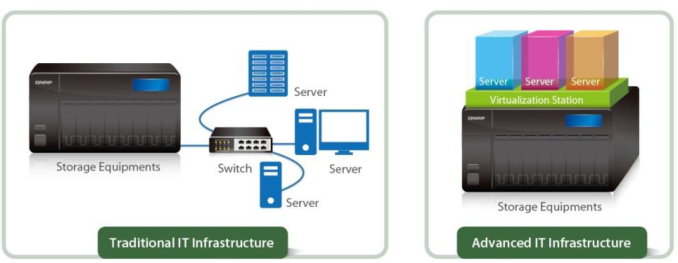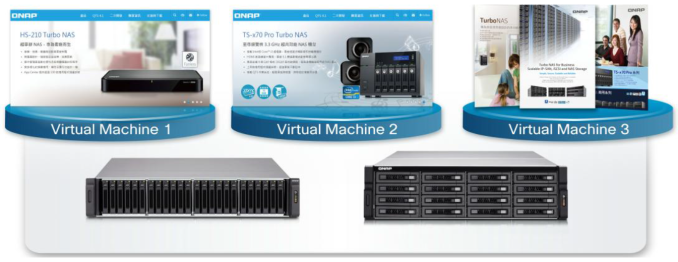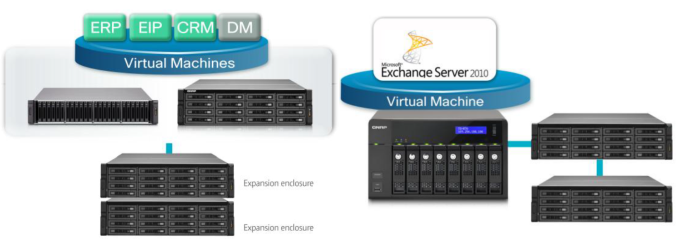NAS Units as VM Hosts: QNAP's Virtualization Station Explored
by Ganesh T S on August 18, 2014 10:15 AM EST- Posted in
- NAS
- Storage
- Virtualization
- QNAP
QNAP's Virtualization Station
The Virtualization Station package in QTS 4.x supports the installation of multiple operating systems in the VMs. QNAP contends that applications installed on VMs can improve the NAS compatibility (say, reading and working with CAD files can be achieved by installation of the appropriate software in the VM when such software is not available as a QTS package). The more obvious benefit is the aggregation of IT infrastructure.
The obvious benefits of VMs translate to the Virtualization Station package - efficiency in deployment, operation and management of systems.
Traditional NAS units carrying virtualization certifications (such as 'VMware Ready', 'Citrix Ready' and 'Windows Server Certified') provide support for virtualization by offering up storage in an easy-to-use manner (say, as iSCSI targets). Hardware-acceleration such as VMware VAAI and Windows ODX help in reducing the load on the server side by making the NAS do more of the work related to the storage (such as cloning of LUNs / copying data from one part of the LUN to another without clogging up the network links etc.). With Virtualization Station, the NAS itself can act as a hypervisor.
The Virtualization Station package allows running of multiple applications on different OSes at the same time. With the TS-451, however, only one guest OS can be active at a given point of time. Opening of files using VM-installed applications presents a number of benefits - there is no need to utilize the network bandwidth to download the file for opening through a local application - this is particularly useful for remote offices where data may have to travel outside the SMB's intranet. Under the same circumstances, avoiding the file's transfer through the network can also enhance security. Maintaining the data in a VM on the NAS also ensures availability (using QNAP's RAID implementation). QNAP's security apps (AV engines as well as firewall) provide added protection. The data on the Turbo NAS can be mounted via iSCSI or Samba on the VM. We will look into the practical aspects in the next section.
Even though the package doesn't allow for direct import of VHD files for creation of VMs, a wide variety of formats (OVA, OVF, QVM, XML and VMX) are supported in the import function. Similar to most other hypervisor solutions, we also have support for snapshots - these record VM RAM and volume ISO status at a given point in time for later roll-back (if necessary).
QTS also allows for assigning different VMs to different users, preventing accidental power-off or any other similar interruptions due to user errors. In terms of added flexibility, power scheduling of the VMs can also be set up.
In their marketing spiel, QNAP talks about four different use-cases for Virtualization Station:
- IIS web server: The package can allow a single QNAP NAS to host multiple web servers by operating existing web pages and databases on a VM. The NAS provides high-speed dedicated connections for each web server and large storage capacity.
- ERP / CRM systems: With a high-end QNAP NAS (Xeon-class CPU and 10 GbE) utilizing SSD caching, these applications can be provided excellent computing resources while ensuring continued data availability using the RAID storage of the NAS in the back-end.
- Microsoft Exchange Server: Many SMBs / SMEs already run their Exchange Server as a VM. Doing it on a QNAP NAS allows large storage capacity for the mail content. Data backup strategies can be executed easily and capacity expansion is also much simplified. From the end-user perspective, archived e-mails can be browsed without downloading.
- Windows Active Directory Server: A VM running this could be on the QNAP NAS and there would be no need for a separate physical machine on the network to run this.
All the use-cases highlighted above target SMB / SME applications. However, our focus today is on the TS-451 which targets enthusiasts and power users in the SOHO / home consumer category.













38 Comments
View All Comments
bsd228 - Tuesday, August 19, 2014 - link
The advantage of having the VM on the filer is that you're not transferring the data twice (not really a concern for the mtdaap server, but more so for the streaming HD video). And with Haswell cpus now taking the same sort of power draw as recent year Atoms and ARMs, you have this cpu capacity for nearly the same energy cost. But that makes more sense on a bigger box that this one. The only point to a single VM option is to support one app class/OS that QNAP doesn't offer natively.Solandri - Monday, August 18, 2014 - link
I built my own combo NAS/VM server after a lot of research. After running it for 3 years, the two (opposing) key points to me are:- Starting with Sandy Bridge, the i5 and i7 Intel CPUs are extremely efficient at idle. You can put them into a 24/7 device like a NAS and they won't cost you substantially more in electricity than a regular NAS. Yet they will have lots of processing power on tap for the occasions when a VM needs it. The Celeron in the TS-451 really isn't appropriate for this type of device. Almost the same idle power, much less peak processing power.
- There is something to be said for keeping your NAS separate from your VMs. It's rare, but I have had a VM crash or hang the hypervisor (ESXi). I only use this at home so it's no big deal when this happens. But in something like a small business environment, I would recommend they be separate devices. Just to be safe.
Learning to use the hypervisor is a bit of a pain, but once you get it down you don't need to be a sysadmin wannabe. After the initial install, ESXi can be controlled entirely with a GUI. I only run one Linux VM (for playing around with), and a FreeNAS VM (FreeBSD) which quite frankly is fire and forget. The rest are Windows VMs (and one OS X VM) for various things I want to keep separate from my personal laptop. e.g. One VM is for CPU-heavy tasks like re-encoding videos, so I can encode "on my laptop" without killing my laptop's battery life. Another is for running my home business, which prevents exposing that VM to whatever malware I might accidentally pick up from browsing websites and trying out new software.
This isn't the only way to skin this cat. I'm contemplating moving most of the VMs to my laptop. Do my general web browsing in one VM, my secure browsing like banking in another, and installing all my apps in another VM so I don't have to reinstall every time I upgrade laptops. Games would be the only apps which run natively. So I'm not saying a combo NAS/VM server is the be-all end-all solution. It's just an option which may suit some people better than others.
deeceefar2 - Monday, August 18, 2014 - link
As someone who is a linux sys admin and a small business owner. I can testify that this product is pretty much right on the money. Time is VERY limited when you run a small business and there is very little time to do IT even when you know how to do it. In the time it would take for me to configure any OS to do what this has out of the box, it would cost me far more in billable time then I would ever make up in cost savings. I used 2 of these to make sure our files would always be operational, and then we used dropbox syncing. There are more ways I could have accomplished that now. This has a virtual machine which can be used to provide a domain server for the network. I use it for visual studio development from my laptop at home so I don't have to deal with switching context on my macbook. SOO many uses for this out of the box. In a corporate environment it may not fit, but anything smaller this is a huge cost savings, and just works.mattlach - Tuesday, August 19, 2014 - link
If it only has the capability to run 1 VM (and with this little RAM, thats really all it can handle), then what is the point? Run bare metal. This is just silly.I'm sorry, but only misguided home/power users are going to buy something like this. If you are a power user you know your stuff, and instead you'll build a real capable ESXi whitebox to use for NAS and virtualization and forgo this cute little consumer style prepackaged crap.
Heck, for about the price of this thing, I just bought a used 12 bay HP ProLiant DL180 G6 with dual 6 core Xeon L5640's and 64GB of registered ECC ram to use as my new basement NAS/Virtualized server.
This thing is completely pointless IMHO.
ganeshts - Tuesday, August 19, 2014 - link
Power consumption? Transcoding capabilities? As I said in another comment, you have to consider the whole package together when deciding on whether to go with the TS-x51 series, not just its virtualization features.I definitely agree with the sentiment that this is not for everyone, but will definitely not say that there is no target market for this. I am quite sure there are plenty of prospective consumers who haven't even cared about what virtualization is, or how to use it to their benefit - For those users, this definitely is a gentle introduction into that world.
Btw, for your used unit - do you have support personnel? RMA capabilities? All those are major factors in pricing a COTS NAS. In my opinion, you are comparing apples and oranges.
beginner99 - Tuesday, August 19, 2014 - link
Target market? I could use it as a NAS and a web server for example. No need to get 2 devices. That would cost more no doubt.nafhan - Tuesday, August 19, 2014 - link
Actually, it'd probably do pretty well in a SOHO environment, especially running several smaller (maybe Linux?) VM's. The thing with servers in a smaller environment is they are often ripe for consolidation as they are almost never fully utilized. You could probably over-provision the memory and CPU resources on this thing (in many use cases) and it probably be completely transparent to the end users. And if office space is at a premium, you'd be taking 4 or 5 boxes and turning it into one.The real question in my mind is why you'd pick this over doing something similar with cloud services...
Arnok666 - Saturday, October 17, 2015 - link
Some areas have crappy internet, so cloud is out, plus who wants to give away all their data?What happens when internet goes down ?
The power usage for this is significantly lower than even a PC with a 250w power supply.
I am looking forward to this, and put my $4k Intel Server up for sale since i can run a couple VM's on this, which is all i need .. not a 750 watt server mostly idling all the time...
Gigaplex - Monday, August 18, 2014 - link
SMB 3.0 support? Do they use a patched Samba or do they have a fully custom stack? I'd like to get my hands on the SMB 3.0 multichannel feature on my homebrew "NAS".deeceefar2 - Monday, August 18, 2014 - link
Interestingly I'm actually using mine for both Power Users Application Scenarios: 1 & 3.I have a TS-460-pro and I upgraded the processor to
Intel Core i7-3770S and the ram to 16 GB KVR16S11K2/16. I can't say enough great things about the QNAP boxes I've had. From a small business perspective it can do pretty much everything you might ask of it.